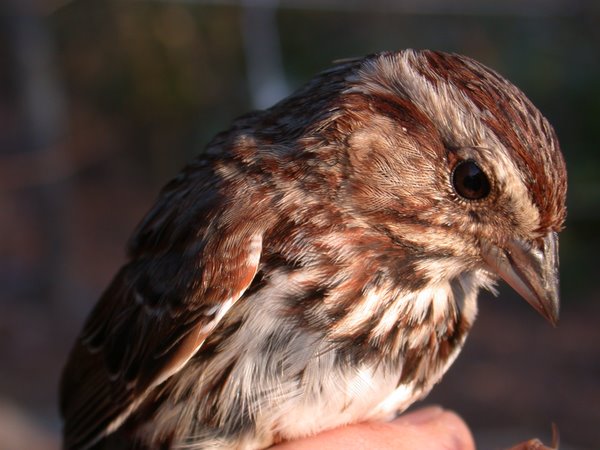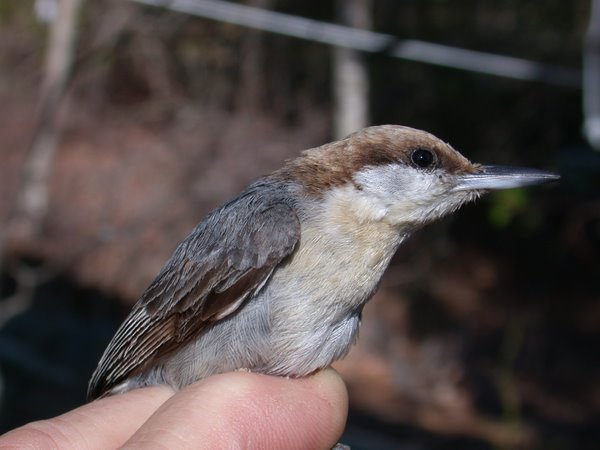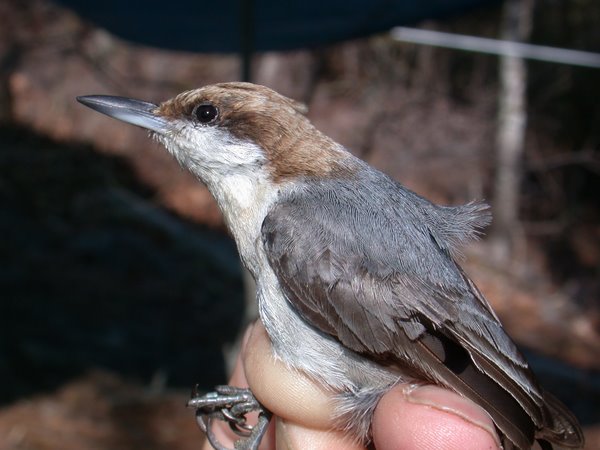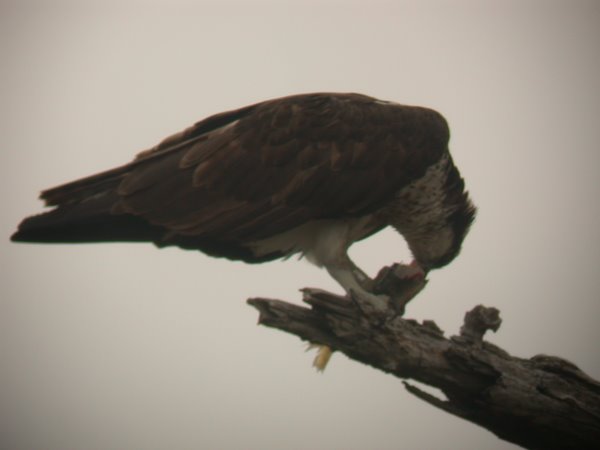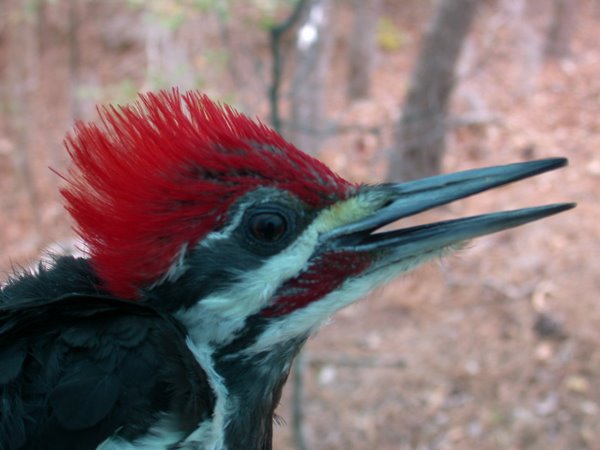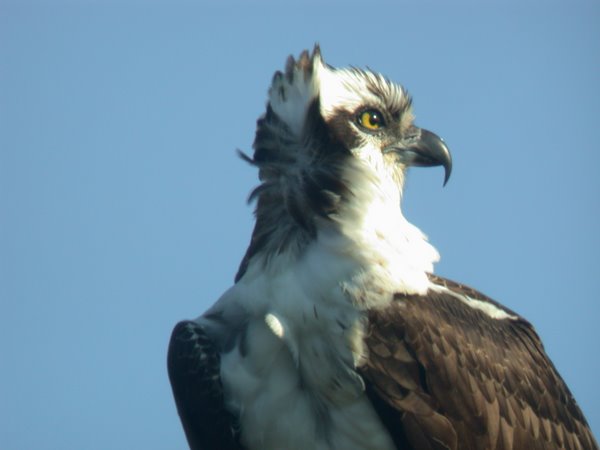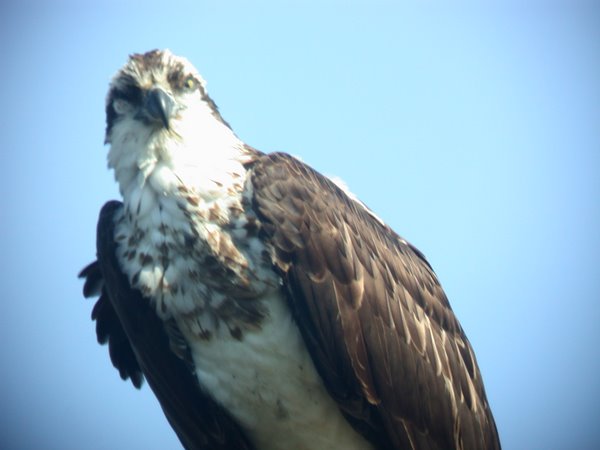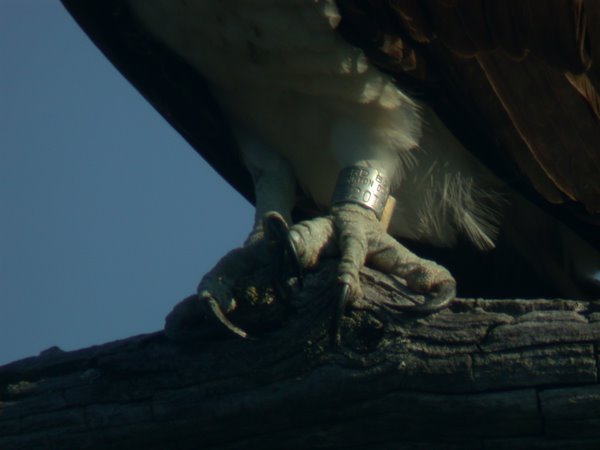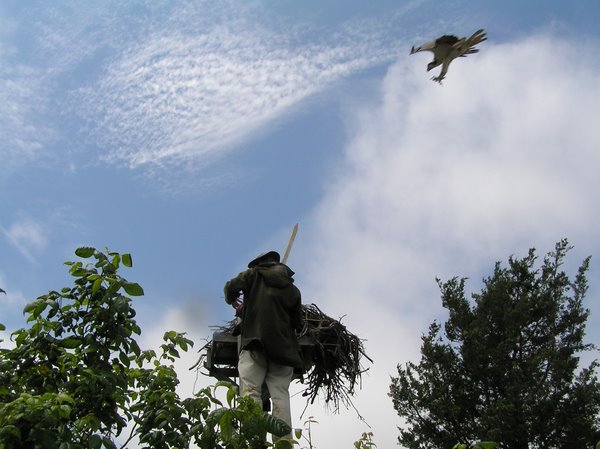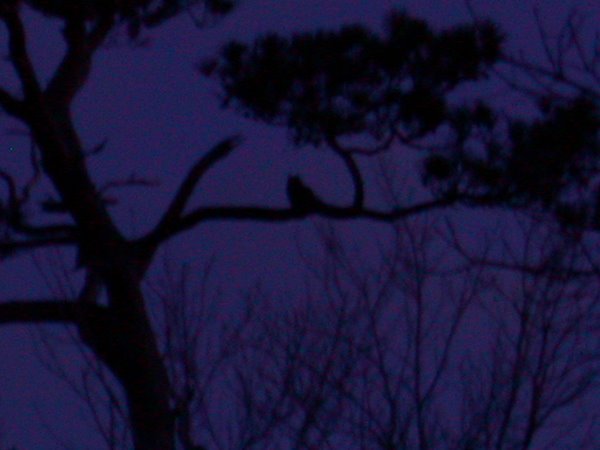Tuesday, March 20, 2007.
Like today, perched on a dead oak tree next to her mate not fifty yards from the banding station in the brilliant morning sunlight. The pair of Osprey almost seemed curious about what I was doing under the ugly blue tarp which covers the picnic tables which comprise our field station. Having banded a few early morning passerines, I put my spotting scope on one bird and then the other. A United States Geological Survey metal band is on the left tarsus of the female. (The female has a brown feathered necklace which distinguishes her from her mate.)
At first I can only make only few digits of the band through my scope. Then he leaves the dead limb and she fidgets and scratches and diddles about. Finally she adjusts her back to absorb the morning sun more completely and flexes a wing like a dog stretches its legs after arising. In time, eight of the nine digits are verified. The numbers are ?788-20124. Now we can learn something of the life history of this wild bird. And we can add something to that history. Incrementally, we will add to knowledge of the natural world of which human beings are but a part.
How is this possible? Within the U.S. Department of the Interior is the U.S. Geological Survey. Within that agency is the Bird Banding Lab ("BBL"). The BBL maintains a central database of all banded birds, with and without color markers. There are a number of ways to report a band to them. On the web see: http://www.pwrc.usgs.gov/bbl/homepage/call800.htm Color-marked shorebirds may also be reported to another office in Canada. See: http://pw1.netcom.com/~djhoff/sbreport.html Each agency will advise the individual reporting the band information of information known about the banded bird.
Today was another slow day at the banding table. No new new species were banded. The last bird of the day was a second-year Pine Warbler. That was only fitting, as their loose trills filled the sunlight of what had become a 72F day.
Peter Doherty
Showing posts with label bird banding. Show all posts
Showing posts with label bird banding. Show all posts
Tuesday, March 20, 2007
Monday, March 19, 2007
A Slow Day with Much Going On!
Sunday, 18 March 2007.
Before dawn at net opening it was 29F with a brisk NW wind and without bird song or call. Six hours later only a single Fox Sparrow was wearing a new band and a mere three, banded Myrtle Warblers had been recaptured. It was a very slow day at the banding table.
Yet, on the predawn walk to the station Great Horned Owls engaged in a territorial hooting contests. In the cold sunlight on and about the two Osprey nests visible from the station, there was calling and copulating. The Brown-headed Nuthatches were tooting their squeaky toys in the loblolly pines above the station. And a Great Egret provided plumage displays which can only be described as "nuptial." Spring was very much in the cold air.
Following three days of banding beginning on March 14th (rained out on the 16th) the tally stands at 34 banded of 10 species with 15 recaptures including an 11th species. A full tally to follow after the first week is completed.
Welcome to the spring 2007 passerine banding season of the Coastal Virginia Wildlife Observatory at First Landing State Park, Virginia Beach, Virginia, waypoint N 36d 54' 21.7"; W 076d 01' 43.7". Weather permitting, the station will be open from one-half hour before local sunrise for at least six hours daily until May 31st. Bird numbers should be at their peak during the last three weeks of April and the first two weeks of May. Although one may only reach the station on foot, visitors are most welcome. This blog will be updated twice weekly.
Peter Doherty, bander.
Before dawn at net opening it was 29F with a brisk NW wind and without bird song or call. Six hours later only a single Fox Sparrow was wearing a new band and a mere three, banded Myrtle Warblers had been recaptured. It was a very slow day at the banding table.
Yet, on the predawn walk to the station Great Horned Owls engaged in a territorial hooting contests. In the cold sunlight on and about the two Osprey nests visible from the station, there was calling and copulating. The Brown-headed Nuthatches were tooting their squeaky toys in the loblolly pines above the station. And a Great Egret provided plumage displays which can only be described as "nuptial." Spring was very much in the cold air.
Following three days of banding beginning on March 14th (rained out on the 16th) the tally stands at 34 banded of 10 species with 15 recaptures including an 11th species. A full tally to follow after the first week is completed.
Welcome to the spring 2007 passerine banding season of the Coastal Virginia Wildlife Observatory at First Landing State Park, Virginia Beach, Virginia, waypoint N 36d 54' 21.7"; W 076d 01' 43.7". Weather permitting, the station will be open from one-half hour before local sunrise for at least six hours daily until May 31st. Bird numbers should be at their peak during the last three weeks of April and the first two weeks of May. Although one may only reach the station on foot, visitors are most welcome. This blog will be updated twice weekly.
Peter Doherty, bander.
Labels:
bird banding,
egret,
fox sparrow,
nuthatch,
osprey
Subscribe to:
Posts (Atom)
